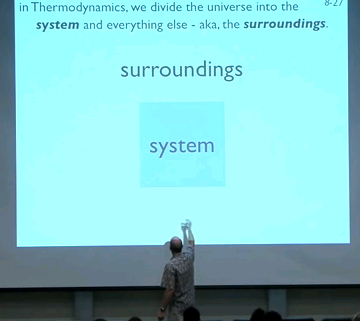UCI Chem 131C Thermodynamics and Chemical Dynamics (Spring 2012)
Lec 08. Thermodynamics and Chemical Dynamics -- The First Law --
View the complete course: ../courses/chem_131c_thermodynamics_and_chemical_dynamics.html
Instructor: Reginald Penner, Ph.D.
License: Creative Commons BY-NC-SA
Terms of Use: ../info.
More courses at http://ocw.uci.edu
Description: In Chemistry 131C, students will study how to calculate macroscopic chemical properties of systems. This course will build on the microscopic understanding (Chemical Physics) to reinforce and expand your understanding of the basic thermo-chemistry concepts from General Chemistry (Physical Chemistry.) We then go on to study how chemical reaction rates are measured and calculated from molecular properties. Topics covered include: Energy, entropy, and the thermodynamic potentials; Chemical equilibrium; and Chemical kinetics. This video is part of a 27-lecture undergraduate-level course titled "Thermodynamics and Chemical Dynamics" taught at UC Irvine by Professor Reginald M. Penner.
Thermodynamics and Chemical Dynamics (Chem 131C) is part of OpenChem: ../openchem/
Recorded on April 18, 2012.
Index of Topics:
00:01 - Announcements
00:58 - Example: the triatomic molecule, chlorine dioxide...
04:27 - Plot of equation (Diagram)
09:40 - Thermodynamics
11:39 - Energy
14:24 - In Thermodynamics, we divide the universe into the system...
15:30 - Diagram: Now there are three flavors of systems:
17:32 - Glossary of Thermodynamic Jargon (Types of Equilibrium)
18:15 - We'll be talking about closed systems until further notice.
20:23 - now, we know what heat is, but what is work?
21:28 - let's think about mechanical work...
23:54 - the external force is:
25:57 - now what happens to the volume?
28:27 - Example: Calculate the work required to compress...
30:15 - Our equation for work...
31:45 - Answer: Graphically, this experiment is as shown below...
34:23 - So instead of compressing the piston using the entire mass necessary...
35:01 - Diagram: Step 1
35:18 - Step 2
36:22 - Conclusion:
36:24 - Diagram: so, more steps means less work.
36:52 - In the thermodynamics, a reversible process is any process the direction of which can be reversed by...
38:54 - Diagram: so instead of dividing the mass into two parts...
40:07 - ...add one granule at a time to the piston
40:50 - So as an example...
43:38 - Chart: Summary:
44:37 - Let me just point out that both of these equations conform...
45:47 - other flavors of work...
46:27 - that's w, what about q?
Required attribution: Penner, Reginald Thermodynamics and Chemical Dynamics 131C (UCI OpenCourseWare: University of California, Irvine), ../courses/chem_131c_thermodynamics_and_chemical_dynamics.html. [Access date]. License: Creative Commons Attribution-ShareAlike 3.0 United States License.


